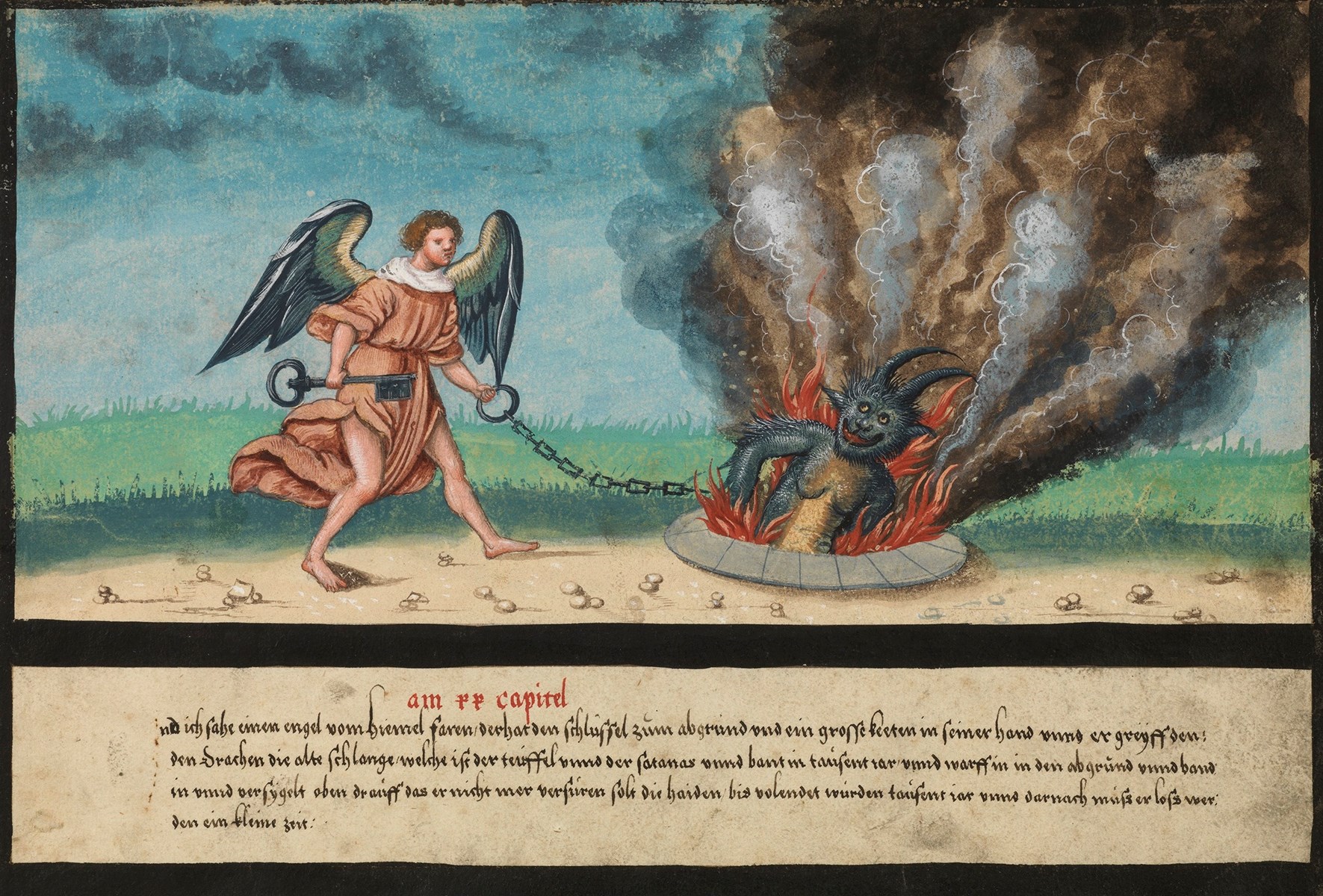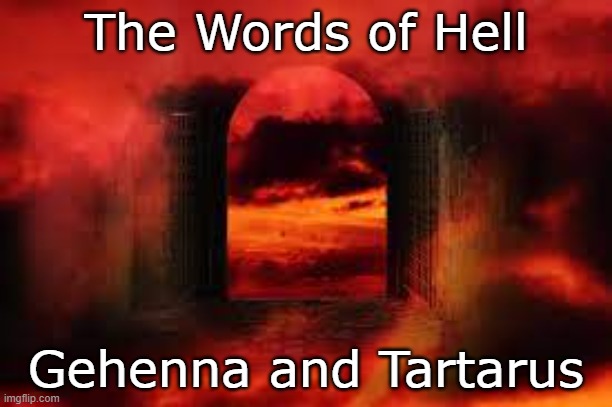Both Tartarus and Gehenna are enigmas within Christian Scripture for various reasons. Most Christians can identify the Greek word commonly assumed to mean hell in the New Testament, which is Gehenna. That word is so full of cultural symbolism, meaning, and inference that I will dedicate an entire series attempting to recognize what Gehenna implies more accurately. This post, however, will consider only the 12 references of Gehenna in the New Testament and offer an indication of how the word is employed in Scripture. The following blog series will be exclusively about Gehenna, the significance and cultural understanding of the term, and how a first-century Jew would acknowledge those statements.
Gehenna in the Synoptic Gospels
The word commonly rendered as hell in the NT only occurs in the three Synoptics (John never mentions it) and one reference in James for 12 references total, with 11 emerging from Jesus. There are 7 references in Matthew, 3 in Mark (all in 1 passage), 1 in Luke, and 1 in James. The initial statement of Gehenna surfaces in the canonical order of the Gospels in Matt 5:22. In that passage, Jesus is delivering the Sermon on the Mount to His disciples and instructs them on their anger when He says, “But I tell you that anyone who is angry with a brother or sister will be subject to judgment. Again, anyone who says to a brother or sister, ‘Raca,’ is answerable to the court. And anyone who says, ‘You fool!’ will be in danger of the fire of hell (Gehenna).” There is no description or explanation of what Gehenna entails, suggesting the disciples (and the crowds gathered to listen) already understood its meaning. In fact, none of the 12 Gehenna statements clarify, with any detail, what precisely Gehenna implies. With one potential exception (Matt 10:28 and its parallel in Luke12:5) every reference to Gehenna is void of any eschatological significance. Additionally, Matthew uses Gehenna periodically in his Gospel with 3 instances coming in the Sermon on the Mount and the other 4 later in his Gospel (I will post all Gehenna verses below). All the references, however, appear to indicate that whatever Gehenna is, it is universally understood amongst the Jews. Therefore, to appreciate the significance, background, and context of this word, a deep dive into second-temple Jewish culture is required.

Mark
In Mark, Gehenna appears 3 times in 1 passage (Mark 9:43-47). That is Mark’s version of the parallel sayings of Jesus during the Sermon on the Mount but articulated somewhat differently. This passage is technically the first reference in the NT because Mark was written slightly earlier than Matthew. Likewise, virtually all scholars agree that Mark was the first Gospel written and that Matthew utilizes Mark as one of his sources. Therefore, Matthew takes what was written in Mark, and conceivably Q (a theorized list of sayings of Jesus), and significantly expands on Mark’s Gehenna sayings. Matthew utilizes Gehenna in varying degrees, while Mark only employs it during the famous Sermon.
Luke
Luke records Gehenna only once. In 12:5 the author states, “But I will show you whom you should fear: Fear him who, after your body has been killed, has authority to throw you into Gehenna. Yes, I tell you, fear him.” It is an obvious parallel to Matthew 10:28, “Do not be afraid of those who kill the body but cannot kill the soul. Rather, be afraid of the One who can destroy both soul and body in Gehenna.” There are a few minor differences between the two, which I hope to write about eventually.
James
The last recording of Gehenna is in James 3:6 where the Apostle states, “The tongue also is a fire, a world of evil among the parts of the body. It corrupts the whole body, sets the whole course of one’s life on fire, and is itself set on fire by hell (Gehenna).” According to James, Gehenna is absolutely connected to “fire.” Unfortunately, this verse from James does not indicate the final destiny of non-Christians, let alone anything analogous to having faith in Christ or risking being sent to hell.
Biblical References
Just so everyone can see the references for themselves, here is a comprehensive list of all the Gehenna sayings in the CSB Bible, less the English word hell:
Matthew 5:22: But I tell you that anyone who is angry with a brother or sister will be subject to judgment. Again, anyone who says to a brother or sister, ‘Raca,’ is answerable to the court. And anyone who says, ‘You fool!’ will be in danger of the fire of Gehenna.
Matthew 5:29: If your right eye causes you to stumble, gouge it out and throw it away. It is better for you to lose one part of your body than for your whole body to be thrown into Gehenna.
Matthew 5:30: And if your right hand causes you to stumble, cut it off and throw it away. It is better for you to lose one part of your body than for your whole body to go into Gehenna.
Matthew 10:28: Do not be afraid of those who kill the body but cannot kill the soul. Rather, be afraid of the One who can destroy both soul and body in Gehenna.
Matthew 18:9: And if your eye causes you to stumble, gouge it out and throw it away. It is better for you to enter life with one eye than to have two eyes and be thrown into the fire of Gehenna.
Matthew 23:15: “Woe to you, teachers of the law and Pharisees, you hypocrites! You travel over land and sea to win a single convert, and when you have succeeded, you make them twice as much a child of Gehenna as you are.
Matthew 23:33: “You snakes! You brood of vipers! How will you escape being condemned to Gehenna?
Mark 9:43: If your hand causes you to stumble, cut it off. It is better for you to enter life maimed than with two hands to go into Gehenna, where the fire never goes out.
Mark 9:45: And if your foot causes you to stumble, cut it off. It is better for you to enter life crippled than to have two feet and be thrown into Gehenna.
Mark 9:47: And if your eye causes you to stumble, pluck it out. It is better for you to enter the kingdom of God with one eye than to have two eyes and be thrown into Gehenna,
Luke 12:5: But I will show you whom you should fear: Fear him who, after your body has been killed, has authority to throw you into Gehenna. Yes, I tell you, fear him.
James 3:6: The tongue also is a fire, a world of evil among the parts of the body. It corrupts the whole body, sets the whole course of one’s life on fire, and is itself set on fire by Gehenna.

Though I will significantly expand on this word in the subsequent series, (first post in the Gehenna series is HERE) the most important detail that deserves consideration is that Gehenna, literally translated, means “The Valley of Hinnom.” Jesus literally said, “And anyone who says, ‘You fool!’ will be in danger of the fire of The Valley of Hinnom.” All scholars concur that Gehenna means The Valley of Hinnom with no disagreements. The issue becomes what Gehenna implies. Does it literally mean the Hinnom Valley? Or does it suggest something else?
When Jesus uses Gehenna, he only uses it concerning the disciples and the Pharisees (the crowd was gathered around the disciples listening to the Sermon on the Mount, so Jesus understandably realized they were listening, but the object of his teaching was to the disciples).
Any other sayings of Jesus in respect to death, including throughout the parables, he uses phrases such as “outer darkness,” “destruction,” and “perish.” He never advises anybody or cautions the general public about Gehenna. Likewise, he never says, “Believe in me or go to Gehenna.” He does inform his disciples, however, about Gehenna (e.g., the Sermon on the Mount), and threatens the Pharisees with it by calling them a “child of Gehenna” or intimidating them with “How will you escape being condemned to Gehenna?” As a result, whatever Jesus asserts Gehenna is, He does not want the disciples to experience it but threatens the religious leaders with its connotation. “Hell” is the most universal and frequently used designation for Gehenna presently, but the challenge is to decipher precisely what Gehenna intended in the first century for an Aramaic-speaking Jew.
Tartarus
(This post will be about the word Tartarus itself within Scripture. I previously wrote a blog on the History of Tartarus, which can be found HERE.)
Unlike Gehenna, Tartarus is one of those words and/or places mentioned in the Bible that not many people are aware of. It is a hapex legomena, meaning “used once,” since it occurs only one time in Scripture, in 2 Peter 2:4, when the author writes, “For if God did not spare angels when they sinned, but sent them to hell (Tartarus), putting them in chains of darkness to be held for judgment.” All major modern translations used in churches and on bookshelves in the Bible bookstore today substitute the word “hell” in place of the original Tartarus, so most people are not aware of its presence in the Bible. Several formal equivalent translations, like the ESV, at least put a footnote after the verse to denote the word “hell” is actually the Greek word Tartarus (technically Tartarosas, a verb meaning “go into Tartarus”). However, some lesser-known translations use different terminology to translate Tartarus, such as “the lowest level of the Underworld” (CEB), “gloomy dungeons lower than Sheol (CJB—Complete Jewish Bible), “deepest pit of gloom,” (DBY—Darby translation), “the deepest abyss” (JUB—Jubilee Bible), and “held captive in Tartarus” (LEX—Lexham English Bible). Though many of these examples cited are much more literal with their translation of Tartarus, the mainline translations using “hell” is nonetheless relatively accurate.

Tartarus in Scripture
There are also references Jude 6, when the author writes, “And the angels who did not keep their positions of authority but abandoned their proper dwelling—these he has kept in darkness, bound with everlasting chains for judgment on the great Day.” Compare this verse to 2 Peter 2:4, and the similarities are obvious. Jude may not use the word Tartarus specifically, but his reference is nonetheless clear. These two Scriptural references may or may not be dependent upon one another. However, most scholars affirm that they may have used a common source, which is generally assumed as the apocryphal book of 1 Enoch. Likewise, Jude also quotes from 1 Enoch in Jude 14 with the quote of “Enoch, the seventh from Adam…” There are many other similarities between all three books, with 1 Enoch a few hundred years before the two biblical references. Therefore, it seems evident that it could very well be the original source for the Tartarus allusions, though this is not certain.
Tartarus is similarly used three times in the Septuagint (Greek translation of the Hebrew Old Testament)—twice in Job (40:20, 41:22-23) and once in Proverbs 30:16. The first reference is regarding the primordial mythological creature Behemoth. It describes the creature as “…when he has gone up to a steep mountain, he causes joy to the quadrupeds in the deep (Tartarus).” Similarly, the second reference regards the other primordial chaos beast Leviathan as coming from “the lowest part of the deep (Tartarus).” It is also used in conjunction with the “abyss,” which is always denoted as the deepest part of the sea. For example, Genesis 1:2, says “…and darkness was over the face of the deep (the abyss).” Therefore, both Tartarus and the Abyss are seemingly used interchangeably in the LXX. Interestingly enough, this is likewise where the floodwaters of Noah’s day originated (the abyss).

The one Proverbs reference uses Tartarus in a fascinating way when the author writes, “the grave (Hades), the barren womb (Tartarus), land, which is never satisfied with water, and fire, which never says, ‘Enough!’” Hades is the word translated as “the grave,” and Tartarus is used as “the barren womb” in this verse. It is a curious translation, but if we see Tartarus as a bottomless abyss, parallel in this verse with “never satisfied with water,” then the reference is obviously to something similar to a deep place that is never quenched despite how much water flows into it. There is no comparison, however, of Tartarus in the Masoretic text (Hebrew OT), so this one reference is a peculiar one that will garner more attention in a future blog post.
Previous blog post on the words of hell Hades/Sheol is found HERE
Next blog post on the words of hell “Other words” is found HERE
Further Reading:
Papaioannou, Kim. The Geography of Hell in the Teachings of Jesus. Eugene, OR: Pickwick Publications, 2013.
Bernstein, Alan E. The Formation of Hell: Death and Retribution in the Ancient and Early Christian World. Ithaca, NY: Cornell University Publishing, 1993.
Turner, Alice K. The History of Hell. New York, NY: Houghton Mifflin Harcourt Publishing, 1993


